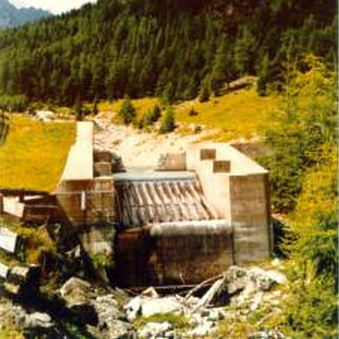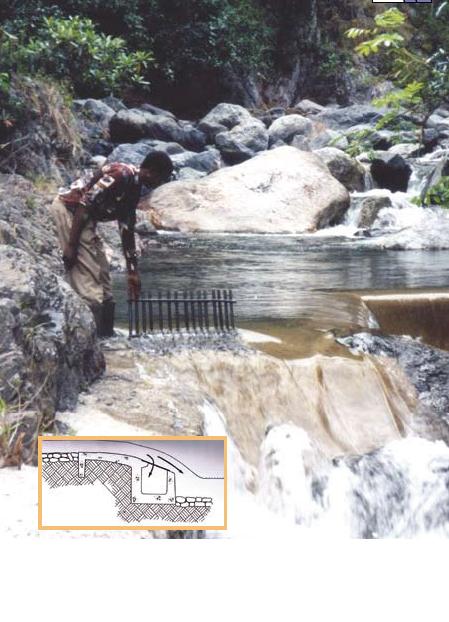Difference between revisions of "Water Portal / Rainwater Harvesting / Surface water / Tyrolean weir"
Eight star (talk | contribs) |
|||
| (14 intermediate revisions by 2 users not shown) | |||
| Line 1: | Line 1: | ||
| − | + | {{Language-box|english_link=Water Portal / Rainwater Harvesting / Surface water / Tyrolean weir | french_link= Coming soon | spanish_link= Toma Tirolesa | hindi_link= वाटर पोर्टल / वर्षाजल संचयन / सतही जल / टाइरोलीन मेड़ | malayalam_link= Coming soon | tamil_link= Coming soon | korean_link= Coming soon | chinese_link=提洛尔堰 | indonesian_link= Bendungan Tyrolean | japanese_link= 水のポータルサイト/雨水貯留/表面水/チロリアン式堰 }} | |
| − | |||
| − | |||
| − | A Tyrolean weir is a water inlet structure in which water is abstracted from the main flow through a screen over a gutter. The gutter is usually made of concrete and built into the river bed. The screen on the crest should slope downstream (15-30 degrees), to increase flow velocities and prevent sediment carried by the stream from blocking it. From the gutter, water enters a pipeline, which drains into a sedimentation tank and then flows by gravity into the rest of the system. | + | [[Image:Tyrolean_weir_icon.png|right|80px]] |
| + | [[Image:Tyrolean weir.JPG|thumb|right|200px|Tyrolean weir|Man checking the grid at a Tyrolean Weir. Tanzania. Photo: D. Bourman, Aqua for All.]] | ||
| + | |||
| + | A '''Tyrolean weir''' is a water inlet structure in which water is abstracted from the main flow through a screen over a gutter. The gutter is usually made of concrete and built into the river bed. The screen on the crest should slope downstream (15-30 degrees), to increase flow velocities and prevent sediment carried by the stream from blocking it. From the gutter, water enters a pipeline, which drains into a sedimentation tank and then flows by gravity into the rest of the system. | ||
Dams and water inlet structures in embankments are vulnerable and expensive elements in river-fed water systems. They are easily damaged by floods, underflow, seepage and suffer from build-up of sediment or rubbish in the water. The Tyrolean weir forms a more reliable and cheaper alternative. | Dams and water inlet structures in embankments are vulnerable and expensive elements in river-fed water systems. They are easily damaged by floods, underflow, seepage and suffer from build-up of sediment or rubbish in the water. The Tyrolean weir forms a more reliable and cheaper alternative. | ||
| − | ==Suitable conditions == | + | ===Suitable conditions === |
Tyrolean intakes are used in small permanent rivers and streams where the sediment content and bed load transport are low, or on the crest of a dam spill. | Tyrolean intakes are used in small permanent rivers and streams where the sediment content and bed load transport are low, or on the crest of a dam spill. | ||
| Line 22: | Line 23: | ||
| valign="top" | - More reliable and cheaper compared to dams and water inlet structures in river embankments <br> | | valign="top" | - More reliable and cheaper compared to dams and water inlet structures in river embankments <br> | ||
- They do not affect water flow to communities downstream | - They do not affect water flow to communities downstream | ||
| − | | valign="top" | | + | | valign="top" | - None known |
|} | |} | ||
| − | ==Resilience to changes in the environment== | + | ===Resilience to changes in the environment=== |
====Drought effects on cement==== | ====Drought effects on cement==== | ||
| Line 36: | Line 37: | ||
More information on managing drought: [[Resilient WASH systems in drought-prone areas]]. | More information on managing drought: [[Resilient WASH systems in drought-prone areas]]. | ||
| − | ==Construction, operations and maintenance== | + | ===Construction, operations and maintenance=== |
| − | [[Image:Tyro weir.jpg|thumb|right| | + | [[Image:Tyro weir.jpg|thumb|right|200px|Tyrolian weirs are meant to intake water from mountain rivers that are very turbulent. Photo: [http://www.tuwien.ac.at/en/tuwien_home/ Vienna University of Technology]]] |
A Tyrolean weir can either consist of parallel rods or a perforated plate, installed in the flow direction over the width of the stream with a 15-30 degree downward slope. Large stones, branches and large leaves cannot pass between the rods, and are prevented from entering the gutter. Because the rods / plate slopes downward, the material in the stream is pushed downstream, until it drops over the end of the weir. | A Tyrolean weir can either consist of parallel rods or a perforated plate, installed in the flow direction over the width of the stream with a 15-30 degree downward slope. Large stones, branches and large leaves cannot pass between the rods, and are prevented from entering the gutter. Because the rods / plate slopes downward, the material in the stream is pushed downstream, until it drops over the end of the weir. | ||
| Line 48: | Line 49: | ||
Regular inspection and cleaning of the grit / rack and possibly the gutter and sedimentation tank is required during and after storm periods. | Regular inspection and cleaning of the grit / rack and possibly the gutter and sedimentation tank is required during and after storm periods. | ||
| − | ==Costs== | + | ===Costs=== |
* Material (excluding the pipe and sedimentation tank): US$ 300 - 600. | * Material (excluding the pipe and sedimentation tank): US$ 300 - 600. | ||
* Labour (if site is easily accessible): 30 - 50 man days. | * Labour (if site is easily accessible): 30 - 50 man days. | ||
| − | = | + | ===Manuals, videos and links=== |
| − | + | * [http://www.samsamwater.com/library/TP40_11_Surface_water.pdf Surface water intake and small dams]. Chapter 11. Revised by Nhamo Masanganise. | |
| − | ==Manuals, videos | ||
| − | ==Acknowledgements== | + | ===Acknowledgements=== |
* CARE Nederland, Desk Study: [[Resilient WASH systems in drought-prone areas]]. October 2010. | * CARE Nederland, Desk Study: [[Resilient WASH systems in drought-prone areas]]. October 2010. | ||
Latest revision as of 06:56, 22 October 2017
| |
|
|
|
|
|
|
|
|
A Tyrolean weir is a water inlet structure in which water is abstracted from the main flow through a screen over a gutter. The gutter is usually made of concrete and built into the river bed. The screen on the crest should slope downstream (15-30 degrees), to increase flow velocities and prevent sediment carried by the stream from blocking it. From the gutter, water enters a pipeline, which drains into a sedimentation tank and then flows by gravity into the rest of the system.
Dams and water inlet structures in embankments are vulnerable and expensive elements in river-fed water systems. They are easily damaged by floods, underflow, seepage and suffer from build-up of sediment or rubbish in the water. The Tyrolean weir forms a more reliable and cheaper alternative.
Contents
Suitable conditions
Tyrolean intakes are used in small permanent rivers and streams where the sediment content and bed load transport are low, or on the crest of a dam spill.
The weir or intake should be carefully sited.
The weir itself does not clean or purify the water.
| Advantages | Disadvantages |
|---|---|
| - More reliable and cheaper compared to dams and water inlet structures in river embankments - They do not affect water flow to communities downstream |
- None known |
Resilience to changes in the environment
Drought effects on cement
Effects of drought: Badly made concrete or cracked linings (e.g. in tanks, dams, waterways, wells, and other structures).
Underlying causes of effects: Less water used for curing; Impure water used for mixing.
To increase resiliency of WASH system: Ensure adequate mixing, ratios, purity of ingredients; Minimize water content in mixture; Ensure adequate curing.
More information on managing drought: Resilient WASH systems in drought-prone areas.
Construction, operations and maintenance

A Tyrolean weir can either consist of parallel rods or a perforated plate, installed in the flow direction over the width of the stream with a 15-30 degree downward slope. Large stones, branches and large leaves cannot pass between the rods, and are prevented from entering the gutter. Because the rods / plate slopes downward, the material in the stream is pushed downstream, until it drops over the end of the weir.
The threshold can be a concrete elevation above the rocky bed of a mountain stream, or a vertical low weir structure, anchored in the embankment. The capacity of the inlet pipe / drain (diameter and gradient) should be 30% more than the design flow and have an uniform gradient to prevent accumulation of sand. The sedimentation tank can accumulate 1.5-2 m3 of deposits and allows water to filter for 10 to 30 minutes at very low speed. It is cleaned by washing it out.
Maintenance
Several visits per year to the site are necessary for inspection, cleaning and minor repairs. Overall, maintenance is easy to carry out due to low-tech structure and the use of local labour and materials.
Regular inspection and cleaning of the grit / rack and possibly the gutter and sedimentation tank is required during and after storm periods.
Costs
- Material (excluding the pipe and sedimentation tank): US$ 300 - 600.
- Labour (if site is easily accessible): 30 - 50 man days.
Manuals, videos and links
- Surface water intake and small dams. Chapter 11. Revised by Nhamo Masanganise.
Acknowledgements
- CARE Nederland, Desk Study: Resilient WASH systems in drought-prone areas. October 2010.

